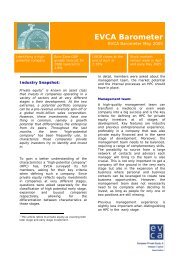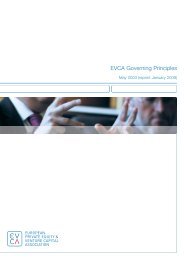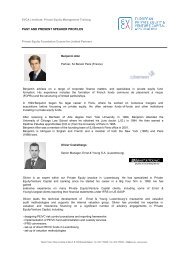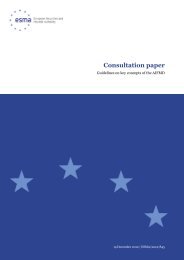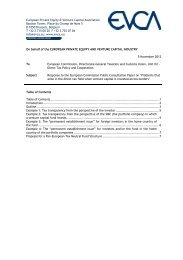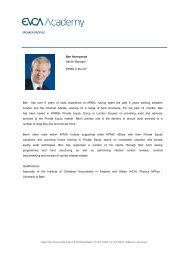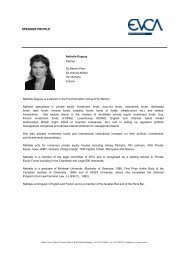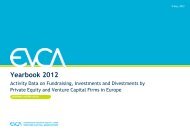Risk Measurement Guidelines - EVCA
Risk Measurement Guidelines - EVCA
Risk Measurement Guidelines - EVCA
You also want an ePaper? Increase the reach of your titles
YUMPU automatically turns print PDFs into web optimized ePapers that Google loves.
I. To be objective and unbiased, the verification andvalidation processes should be conducted independently.This can be done by independent qualified internalstaff or through an external review prior to actualreliance on a model, and periodically thereafter.II. For their risk measurement, limited partners shoulduse several sources to be able to capture all relevantavailable market data. Sensitivity analysis, stresstesting, qualitative assessment and judgment areappropriate ways of overcoming data scarcity andshowing that results are still valid under morepessimistic conditions.III. Knowledge gained from the monitoring of funds has tobe incorporated in risk measurement. Judgment hasto be structured and well documented. Models shouldnot be based on the assumption that the limitedpartner has above-average selection skills.IV. Market indices are important as one modelling inputand as benchmarks for risk measurement but cannotbe a substitute for a risk model that is specific to aninstitutional investor’s portfolio of funds.<strong>Risk</strong> measurement models should not be static and need tobe improved continuously. They not only have to incorporaterelevant past data but should also evolve with new informationand adapt to a changing environment. Models should beregularly validated and verified. Limited partners need toensure that choices of reference data and scenarios do notassume they have above-average selection skills.Scarcity of data on the universe of private equity funds canbe a major obstacle to precise risk measurement and toback-testing of models. For example, smaller private equityinvestment programmes will have good quality data only ontheir investee funds. Investors in the early stages of buildingup portfolios of private equity funds will face similar issues.In addition, where investors are exposed to venture capitalinvestment in innovation, the past does not always providea reliable yardstick for the future. In situations where thereare significant difficulties in accessing good quality andrepresentative data, assumptions and modelling choices,well documented judgment, stress testing and scenarioanalysis have to play a significant role.<strong>Risk</strong> models use a variety of indices related to public marketsas well as private equity market-specific ones. The mappingof the overall portfolio on the market indices has to be clearlydefined. The (sub-)indices used to quantify shocks or volatilitymust be representative and consistent with the structure(notably diversification, quality, stage in the funds’ lifecycleand the investor’s funding liquidity test) of the (sub-)portfoliosto be modelled. In the case of private equity market indices,the completeness and quality of the data needs to be takeninto consideration.<strong>EVCA</strong> <strong>Risk</strong> <strong>Measurement</strong> <strong>Guidelines</strong> 2013 I 31



